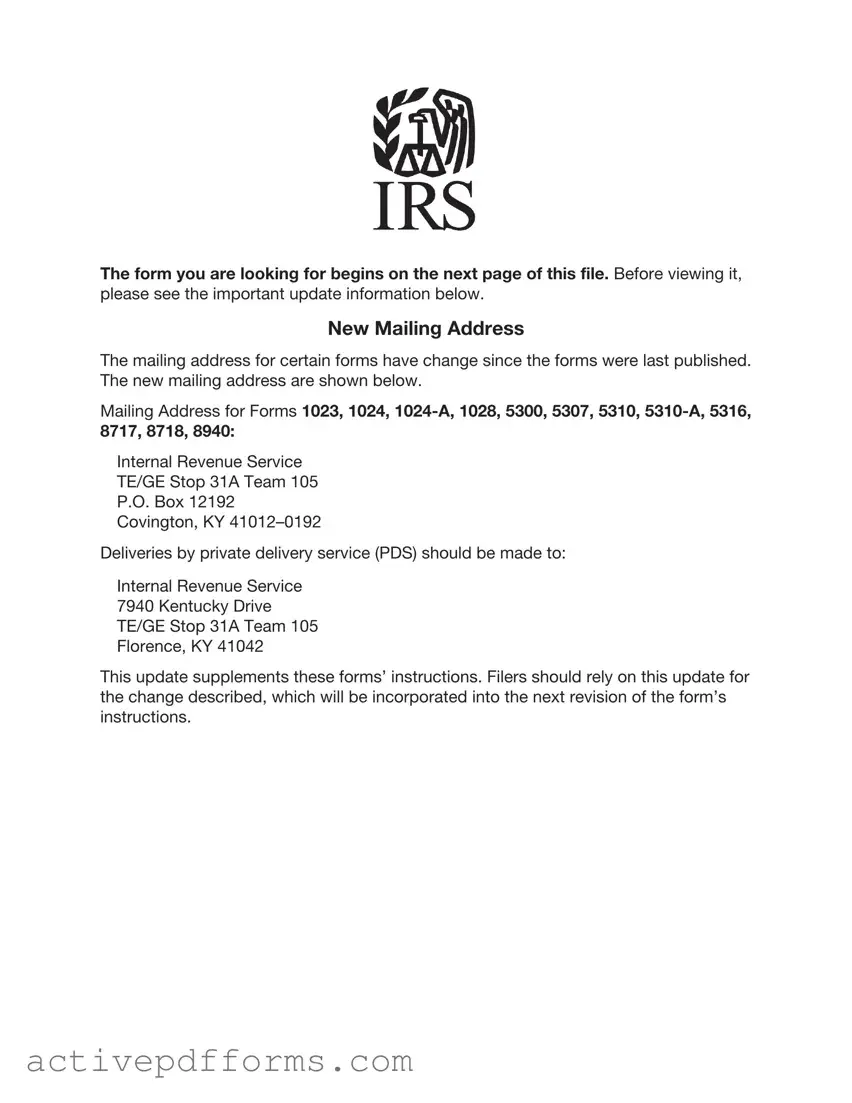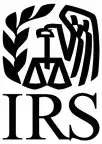The form you are looking for begins on the next page of this file. Before viewing it, please see the important update information below.
New Mailing Address
The mailing address for certain forms have change since the forms were last published. The new mailing address are shown below.
Mailing Address for Forms 1023, 1024, 1024-A, 1028, 5300, 5307, 5310, 5310-A, 5316, 8717, 8718, 8940:
Internal Revenue Service
TE/GE Stop 31A Team 105
P.O. Box 12192
Covington, KY 41012–0192
Deliveries by private delivery service (PDS) should be made to:
Internal Revenue Service
7940 Kentucky Drive
TE/GE Stop 31A Team 105
Florence, KY 41042
This update supplements these forms’ instructions. Filers should rely on this update for the change described, which will be incorporated into the next revision of the form’s instructions.
This page intentionally left blank.
Form 1024 (Rev. January 2018)
Department of the Treasury Internal Revenue Service
Application for Recognition of Exemption
Under Section 501(a)
Go to www.irs.gov/Form1024 for instructions and the latest information.
OMB No. 1545-0057
If exempt status is approved, this application will be open for public inspection.
Read the instructions for each Part carefully. A User Fee must be attached to this application.
If the required information and appropriate documents are not submitted along with Form 8718 (with payment of the
appropriate user fee), the application may be returned to the organization.
Complete the Procedural Checklist that follows the form.
Part I. Identification of Applicant Must be completed by all applicants; also complete appropriate schedule. Submit only the schedule that applies to your organization. Do not submit blank schedules.
Check the appropriate box below to indicate the section under which the organization is applying:
a
 Section 501(c)(2)—Title holding corporations (Schedule A)
Section 501(c)(2)—Title holding corporations (Schedule A)
b
 Reserved for future use
Reserved for future use
c |
Section 501(c)(5)—Labor, agricultural, or horticultural organizations (Schedule C) |
d
 Section 501(c)(6)—Business leagues, chambers of commerce, etc. (Schedule C)
Section 501(c)(6)—Business leagues, chambers of commerce, etc. (Schedule C)
e |
Section 501(c)(7)—Social clubs (Schedule D) |
f |
Section 501(c)(8)—Fraternal beneficiary societies, etc., providing life, sick, accident, or other benefits to members (Schedule E) |
g |
Section 501(c)(9)—Voluntary employees’ beneficiary associations (Parts I through IV and Schedule F) |
h |
Section 501(c)(10)—Domestic fraternal societies, orders, etc., not providing life, sick, accident, or other benefits (Schedule E) |
i |
Section 501(c)(12)—Benevolent life insurance associations, mutual ditch or irrigation companies, mutual or cooperative telephone |
|
companies, or like organizations (Schedule G) |
j
 Section 501(c)(13)—Cemeteries, crematoria, and like corporations (Schedule H)
Section 501(c)(13)—Cemeteries, crematoria, and like corporations (Schedule H)
k |
Section 501(c)(15)—Mutual insurance companies or associations, other than life or marine (Schedule I) |
l |
Section 501(c)(17)—Trusts providing for the payment of supplemental unemployment compensation benefits (Parts I through IV and Schedule J) |
m |
Section 501(c)(19)—A post, organization, auxiliary unit, etc., of past or present members of the Armed Forces of the United States (Schedule K) |
n |
Section 501(c)(25)—Title holding corporations or trusts (Schedule A) |
|
|
|
|
|
|
1a |
Full name of organization (as shown in organizing document) |
2 Employer identification number (EIN) (if |
|
|
|
|
|
none, see Specific Instructions) |
|
|
|
|
1b c/o Name (if applicable) |
|
|
3 Name and telephone number of person to be |
|
|
|
|
|
contacted if additional information is needed |
|
|
|
|
|
|
1c |
Address (number and street) |
|
Room/Suite |
|
|
|
|
|
|
|
|
1d |
City, town or post office, state, and ZIP + 4. If you have a foreign address, see Specific |
|
|
|
Instructions for Part I. |
|
|
|
|
|
|
|
|
( |
) |
1e |
Web site address |
4 Month the annual accounting period ends |
5 Date incorporated or formed |
|
|
|
|
|
|
6Did the organization previously apply for recognition of exemption under this Code section or under any other section of the Code? If “Yes,” attach an explanation.
7 Has the organization filed Federal income tax returns or exempt organization information returns? . . . . . . . .
If “Yes,” state the form numbers, years filed, and Internal Revenue office where filed.
8Check the box for the type of organization. ATTACH A CONFORMED COPY OF THE CORRESPONDING ORGANIZING DOCUMENTS TO THE APPLICATION BEFORE MAILING.
a |
Corporation— |
Attach a copy of the Articles of Incorporation (including amendments and restatements) showing approval by the |
|
|
appropriate state official; also attach a copy of the bylaws. |
b |
Trust— |
Attach a copy of the Trust Indenture or Agreement, including all appropriate signatures and dates. |
c |
Association— |
Attach a copy of the Articles of Association, Constitution, or other creating document, with a declaration (see instructions) |
|
|
or other evidence that the organization was formed by adoption of the document by more than one person. Also include a |
|
|
copy of the bylaws. |
If this is a corporation or an unincorporated association that has not yet adopted bylaws, check here . . . . . . . .
I declare under the penalties of perjury that I am authorized to sign this application on behalf of the above organization, and that I have examined this application, including the accompanying schedules and attachments, and to the best of my knowledge it is true, correct, and complete.
PLEASE |
F |
|
SIGN |
|
HERE |
(Signature) |
For Paperwork Reduction Act Notice, see instructions.
(Type or print name and title or authority of signer) |
(Date) |
Catalog No. 12343K |
Form 1024 (Rev. 1-2018) |
Form 1024 (Rev. 1-2018) |
Page 2 |
Part II. Activities and Operational Information (Must be completed by all applicants)
1Provide a detailed narrative description of all the activities of the organization—past, present, and planned. Do not merely refer to or repeat the language in the organizational document. List each activity separately in the order of importance based on the relative time and other resources devoted to the activity. Indicate the percentage of time for each activity. Each description should include, as a minimum, the following: (a) a detailed description of the activity including its purpose and how each activity furthers your exempt purpose; (b) when the activity was or will be initiated; and (c) where and by whom the activity will be conducted.
2List the organization’s present and future sources of financial support, beginning with the largest source first.
Form 1024 (Rev. 1-2018) |
Page 3 |
Part II. Activities and Operational Information (continued)
3Give the following information about the organization’s governing body:
a Names, addresses, and titles of officers, directors, trustees, etc.
4If the organization is the outgrowth or continuation of any form of predecessor, state the name of each predecessor, the period during which it was in existence, and the reasons for its termination. Submit copies of all papers by which any transfer of assets was effected.
5If the applicant organization is now, or plans to be, connected in any way with any other organization, describe the other organization and explain the relationship (for example, financial support on a continuing basis; shared facilities or employees; same officers, directors, or trustees).
6If the organization has capital stock issued and outstanding, state: (1) class or classes of the stock; (2) number and par value of the shares;
(3) consideration for which they were issued; and (4) if any dividends have been paid or whether your organization’s creating instrument authorizes dividend payments on any class of capital stock.
7State the qualifications necessary for membership in the organization; the classes of membership (with the number of members in each class); and the voting rights and privileges received. If any group or class of persons is required to join, describe the requirement and explain the relationship between those members and members who join voluntarily. Submit copies of any membership solicitation material. Attach sample copies of all types of membership certificates issued.
8Explain how your organization’s assets will be distributed on dissolution.
Form 1024 (Rev. 1-2018) |
Page 4 |
Part II. Activities and Operational Information (continued)
9Has the organization made or does it plan to make any distribution of its property or surplus funds to shareholders or
members? . . . . . . . . . . . . . . . . . . . . . . . . . . . . . . . .
If “Yes,” state the full details, including: (1) amounts or value; (2) source of funds or property distributed or to be distributed; and (3) basis of, and authority for, distribution or planned distribution.
10Does, or will, any part of your organization’s receipts represent payments for services performed or to be performed? . If “Yes,” state in detail the amount received and the character of the services performed or to be performed.
11Has the organization made, or does it plan to make, any payments to members or shareholders for services performed or
to be performed? . . . . . . . . . . . . . . . . . . . . . . . . . . . . . .
If “Yes,” state in detail the amount paid, the character of the services, and to whom the payments have been, or will be, made.
12Does the organization have any arrangement to provide insurance for members, their dependents, or others (including
provisions for the payment of sick or death benefits, pensions, or annuities)? . . . . . . . . . . . . .
If “Yes,” describe and explain the arrangement’s eligibility rules and attach a sample copy of each plan document and each type of policy issued.
13Is the organization under the supervisory jurisdiction of any public regulatory body, such as a social welfare agency, etc.? If “Yes,” submit copies of all administrative opinions or court decisions regarding this supervision, as well as copies of applications or requests for the opinions or decisions.
14 Does the organization now lease or does it plan to lease any property? . . . . . . . . . . . . . . .
If “Yes,” explain in detail. Include the amount of rent, a description of the property, and any relationship between the applicant organization and the other party. Also, attach a copy of any rental or lease agreement. (If the organization is a party, as a lessor, to multiple leases of rental real property under similar lease agreements, please attach a single representative copy of the leases.)
15Has the organization spent or does it plan to spend any money attempting to influence the selection, nomination, election,
or appointment of any person to any federal, state, or local public office or to an office in a political organization? . . If “Yes,” explain in detail and list the amounts spent or to be spent in each case.
16 Does the organization publish pamphlets, brochures, newsletters, journals, or similar printed material? . . . . .
If “Yes,” attach a recent copy of each.
Form 1024 (Rev. 1-2018) |
Page 5 |
Part III. Financial Data (Must be completed by all applicants) |
|
Complete the financial statements for the current year and for each of the 3 years immediately before it. If in existence less than 4 years, complete the statements for each year in existence. If in existence less than 1 year, also provide proposed budgets for the 2 years following the current year.
A. Statement of Revenue and Expenses
|
Revenue |
1 |
Gross dues and assessments of members . . . |
2 |
Gross contributions, gifts, etc |
3Gross amounts derived from activities related to the organization’s exempt purpose (attach schedule)
(Include related cost of sales on line 9.) . . . .
4Gross amounts from unrelated business activities (attach schedule)
5 Gain from sale of assets, excluding inventory items
|
(attach schedule) |
. . . . . . . . . . |
6 |
Investment income (see instructions) |
7 |
Other revenue (attach schedule) |
8Total revenue (add lines 1 through 7) . . . . .
Expenses
9Expenses attributable to activities related to the organization’s exempt purposes . . . . . .
10Expenses attributable to unrelated business activities
11Contributions, gifts, grants, and similar amounts paid
(attach schedule) |
. . . . . . . . . . |
12Disbursements to or for the benefit of members (attach schedule)
13Compensation of officers, directors, and trustees (attach schedule)
14 |
Other salaries and wages |
15 |
Interest |
16 |
Occupancy |
17 |
Depreciation and depletion |
. . . . . . . |
18 |
Other expenses (attach schedule) |
19Total expenses (add lines 9 through 18) . . . .
20Excess of revenue over expenses (line 8 minus
line 19) . . . . . . . . . . . . .
(a) Current Tax Year |
3 Prior Tax Years or Proposed Budget for Next 2 Years |
From |
|
|
|
|
|
(b) |
(c) |
(d) |
To |
|
|
|
|
|
B. Balance Sheet (at the end of the period shown)
|
|
|
Current Tax Year |
|
|
Assets |
as of |
1 |
Cash |
1 |
|
2 |
Accounts receivable, net |
2 |
|
3 |
Inventories |
3 |
|
4 |
Bonds and notes receivable (attach schedule) |
4 |
|
5 |
Corporate stocks (attach schedule) |
5 |
|
6 |
Mortgage loans (attach schedule) |
6 |
|
7 |
Other investments (attach schedule) |
7 |
|
8 |
Depreciable and depletable assets (attach schedule) |
8 |
|
9 |
Land |
9 |
|
10 |
Other assets (attach schedule) |
. . . . . . . . . . . . . . . . . . . . . . . . . . |
10 |
|
11 |
Total assets |
11 |
|
12 |
|
Liabilities |
12 |
|
Accounts payable |
|
13 |
Contributions, gifts, grants, etc., payable |
13 |
|
14 |
Mortgages and notes payable (attach schedule) |
14 |
|
15 |
Other liabilities (attach schedule) |
15 |
|
16 |
Total liabilities |
16 |
|
17 |
|
Fund Balances or Net Assets |
17 |
|
Total fund balances or net assets |
|
18 |
Total liabilities and fund balances or net assets (add line 16 and line 17) |
18 |
|
If there has been any substantial change in any aspect of the organization’s financial activities since the end of the period shown above, check the box and attach a detailed explanation . . . . . . . . . . . . . . . . . . . . . . . . . .
Are you filing Form 1024 within 15 months from the end of the month in which the organization was created or formed as required by section 505(c)? . . . . . . . . . . . . . . . . . . . . . . . . . . . .
If “Yes,” skip the rest of this part.
If “No,” answer question 2.
2 If you answer “No” to question 1, are you filing Form 1024 within 27 months from the end of the month in which the organization was created or formed? . . . . . . . . . . . . . . . . . . . . . . . . . .
If “Yes,” your organization qualifies under Regulations section 301.9100-2 for an automatic 12-month extension of the 15-month filing requirement. Do not answer questions 3 and 4.
If “No,” answer question 3.
3 If you answer “No” to question 2, does the organization wish to request an extension of time to apply under the “reasonable action and good faith” and the “no prejudice to the interest of the government” requirements of Regulations section 301.9100-3? . . . . . . . . . . . . . . . . . . . . . . . . . . . . . .
Section 501(c)(9) and 501(c)(17) organizations:
1
Form 1024 (Rev. 1-2018)
Part IV. Notice Requirements (Sections 501(c)(9) and 501(c)(17) Organizations Only)
If “Yes,” give the reasons for not filing this application within the 27-month period described in question 2. See Specific Instructions, Part IV, Line 3, before completing this item. Do not answer question 4.
If “No,” answer question 4.
4If you answer “No” to question 3, your organization’s qualification as a section 501(c)(9) or 501(c)(17) organization can be recognized only from the date this application is filed. Therefore, does the organization want us to consider its application as a request for recognition of exemption as a section 501(c)(9) or 501(c)(17) organization from the date the application is received and not retroactively to the date the organization was created or formed? . . . . . . . . . . . .

Form 1024 (Rev. 1-2018) |
Page 7 |
Schedule A Organizations described in section 501(c)(2) or 501(c)(25) (Title-holding corporations or trusts)
1State the complete name, address, and EIN of each organization for which title to property is held and the number and type of the applicant organization’s stock held by each organization.
2If the annual excess of revenue over expenses has not been or will not be turned over to the organization for which title to property is held, state the purpose for which the excess is or will be retained by the title holding organization.
3In the case of a corporation described in section 501(c)(2), state the purpose of the organization for which title to property is held (as shown in its governing instrument) and the Code sections under which it is classified as exempt from tax. If the organization has received a determination or ruling letter recognizing it as exempt from taxation, please attach a copy of the letter.
4In the case of a corporation or trust described in section 501(c)(25), state the basis whereby each shareholder is described in section 501(c)(25)(C). For each organization described that has received a determination or ruling letter recognizing that organization as exempt from taxation, please attach a copy of the letter.
5With respect to the activities of the organization.
a Is any rent received attributable to personal property leased with real property? . . . . . . . . . . . .
If “Yes,” what percentage of the total rent, as reported on the financial statements in Part III, is attributable to personal property?
bWill the organization receive income which is incidentally derived from the holding of real property, such as income
from operation of a parking lot or from vending machines? . . . . . . . . . . . . . . . . . .
If “Yes,” what percentage of the organization’s gross income, as reported on the financial statements in Part III, is incidentally derived from the holding of real property?
cWill the organization receive income other than rent from real property or personal property leased with real property or income which is incidentally derived from the holding of real property? . . . . . . . . . . . . . .
If “Yes,” describe the source of the income.
Line 1.—Provide the requested information on each organization for which the applicant organization holds title to property. Also indicate the number and types of shares of the applicant organization’s stock that are held by each.
Line 2.—For purposes of this question, “excess of revenue over expenses” is all of the organization’s income for a particular tax year less operating expenses.
Line 3.—Give the exempt purpose of each organization that is the basis for its exempt status and the Internal Revenue Code section that
describes the organization (as shown in its IRS determination letter).
Line 4.—Indicate if the shareholder is one of the following.
1.A qualified pension, profit-sharing, or stock bonus plan that meets the requirements of the Code;
2.A government plan;
3.An organization described in section 501(c)(3); or
4.An organization described in section 501(c)(25).
Form 1024 (Rev. 1-2018) |
Page 8 |
This page left blank intentionally.




 Section
Section 
 Reserved for future use
Reserved for future use
 Section
Section 
 Section
Section 




